Sigmund’s Gourmet Pasta aims to be the top gourmet pasta restaurant in Eugene, OR. We are building a strong consumer brand with a growing customer base. Our menu features innovative pasta dishes including pesto with smoked salmon, pancetta and peas linguini in alfredo sauce, and fresh mussels and clams in marinara sauce. We also offer distinctive salads, desserts, and beverages.
We strive to revolutionize the pasta experience for individuals, families, and take-away customers with discretionary income. Our goal is to sell high-quality, innovative products at affordable prices. We also prioritize tasteful, convenient locations and excellent customer service.
To finance our first restaurant, we will use a combination of direct owner investment and long-term loans which are guaranteed by the owner’s collateral.
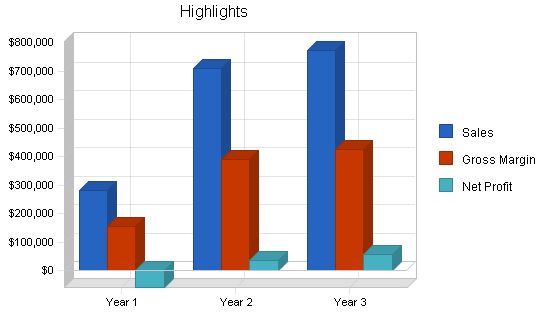
1.1 Objectives:
– Build brand awareness and customer service while growing sales by opening new stores.
– Utilize high quality, innovative menu items with premium vegetables, meats, and cheeses.
– Provide excellent dining value with large portions of fresh, high-quality food for an average guest check of $10 per person.
– Build brand awareness through inexpensive, guerrilla marketing tactics.
– Pursue disciplined restaurant growth.
– Provide superior customer service.
– Leverage the experience, intelligence, and skills of our sophisticated advisory board.
1.2 Mission:
– Provide the finest pasta meal and dining experience to attract and maintain customers.
– Exceed customer expectations.
1.3 Keys to Success:
– Location is critical.
– Consider daytime and evening populations, shopping patterns, car counts, and household income levels.
– Sigmund’s Gourmet Pasta is a gourmet pasta restaurant in Eugene, OR.
– Serves individuals, families, and take-away customers with fresh, creative, attractive pasta dishes, salads, and desserts.
– Uses homemade pasta, fresh vegetables, and premium meats and cheeses.
– Eugene store in the Valley River Shopping Center will serve as the concept store for future stores.
2.1 Company Ownership:
– Sigmund’s is a privately held Oregon Corporation.
– Majority stockholder is Kevin Lewis.
2.2 Start-up Summary:
– Start-up costs include pasta machines, a commercial stove, commercial refrigerators and freezers, a commercial dishwasher, cabinets with cutting board surfaces, chairs and tables, a beverage dispenser, dishware and flatware, assorted knives, mixing bowls, and other food production accessories, a point-of-sale terminal, and a computer with an internet connection, CD-RW, and printer.
– Long-term assets will be depreciated using G.A.A.P. approved straight-line depreciation method.
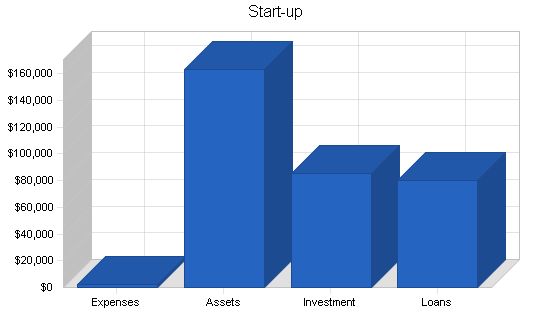
Start-up Funding:
– Start-up Expenses to Fund: $2,100
– Start-up Assets to Fund: $162,900
– Total Funding Required: $165,000
Assets:
– Non-cash Assets from Start-up: $75,000
– Cash Requirements from Start-up: $87,900
– Additional Cash Raised: $0
– Cash Balance on Starting Date: $87,900
– Total Assets: $162,900
Liabilities and Capital:
– Liabilities
– Current Borrowing: $0
– Long-term Liabilities: $80,000
– Accounts Payable (Outstanding Bills): $0
– Other Current Liabilities (interest-free): $0
– Total Liabilities: $80,000
Capital:
– Planned Investment
– Kevin Lewis: $85,000
– Other: $0
– Additional Investment Requirement: $0
– Total Planned Investment: $85,000
– Loss at Start-up (Start-up Expenses): ($2,100)
– Total Capital: $82,900
Total Capital and Liabilities: $162,900
Total Funding: $165,000
Start-up Requirements:
Start-up Expenses:
– Legal: $1,000
– Stationery etc.: $100
– Menus: $1,000
– Insurance: $0
– Rent: $0
– Research and Development: $0
– Expensed Equipment: $0
– Other: $0
– Total Start-up Expenses: $2,100
Start-up Assets:
– Cash Required: $87,900
– Other Current Assets: $0
– Long-term Assets: $75,000
– Total Assets: $162,900
Total Requirements: $165,000
Services:
Sigmund’s has created gourmet pastas and salads that are differentiated and superior to competitors. Customers can taste the quality and freshness of the product in every bite. The following are some characteristics of the product:
1. Sigmund’s dough is made with Italian semolina flour.
2. Cheeses are all imported.
3. Vegetables are organic and fresh with three shipments a week.
4. Meats are all top-shelf varieties, organic when possible.
At Sigmund’s, food is not the only product. Sigmund’s prides themselves on providing service that is on par with fine dining. This is accomplished through an extensive training program and only hiring experienced employees.
At A Glance–The Prototype Sigmund’s Store:
– Location: an upscale mall, suburban neighborhood, or urban retail district.
– Design: bright, hip, and clean.
– Size: 1,200-1,700 square feet.
– Employees: six to seven full time.
– Seating: 35-45.
– Types of transactions: 80% dine in, 20% take away.
Market Analysis Summary:
The market can be divided into three target markets, individuals, families, and take-away business. Please see the next session for an intricate analysis of the different segments.
Sigmund’s expansion strategy is to further penetrate the existing markets by opening an additional store (or stores) in Eugene in 2004. This clustering approach enables Sigmund’s Gourmet Pasta to increase brand awareness and improve operating and marketing efficiencies. For example:
– Clustering allows Sigmund’s to negotiate a fixed percentage contract with the food wholesalers.
– Marketing expenditures can be spread over multiple revenue centers. This strategy reduces risks involved with opening new restaurants given that Sigmund’s better understands the competitive conditions, consumer tastes, and spending patterns in the market. When the Eugene market is saturated with one or two additional stores, then Sigmund’s intends to look at new markets.
Market Segmentation:
The market can be segmented into three target populations:
– Individuals: people that dine in by themselves.
– Families: a group of people, either friends or a group of non-nuclear relatives dining together.
– Take away: people that prefer to eat Sigmund’s food at another location.
Sigmund’s customers are hungry individuals between the ages of 25 and 50, making up 53% of Eugene (Eugene Chamber of Commerce). Age is not the most defined demographic of this customer base; all age groups enjoy pasta. The most defined characteristic of the target market is income. Gourmet pasta stores have been very successful in high rent, mixed-use urban areas, such as Northwest 23rd in Portland. These areas have a large day and night population consisting of business people and families who have household disposable incomes over $40,000. Combining several key demographic factors, Sigmund’s arrives at a profile of the primary customer as follows:
– Sophisticated families who live nearby.
– Young professionals who work close to the location.
– Shoppers who patronize the high rent stores.
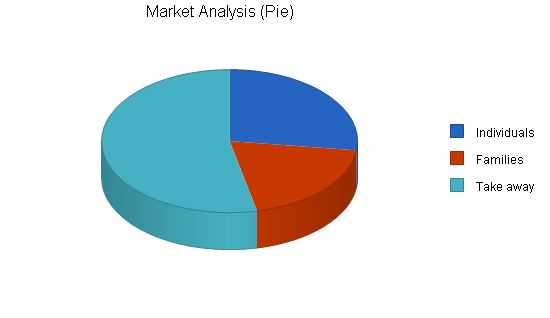
Market Analysis
Year 1 Year 2 Year 3 Year 4 Year 5 CAGR
Potential Customers Growth
Individuals 8% 12,457 13,454 14,530 15,692 16,947 8.00%
Families 9% 8,974 9,782 10,662 11,622 12,668 9.00%
Take away 10% 24,574 27,031 29,734 32,707 35,978 10.00%
Total 9.27% 46,005 50,267 54,926 60,021 65,593 9.27%
4.2 Service Business Analysis
In 1999, global pasta sales reached $8 billion. Pasta sales are estimated to grow at least 10% for the next five years. The big four, Pastabilities, PastaFresh, Pasta Works, and Pasta Perfect contribute $2 billion in combined 2000 revenues. The rest of the market is primarily made up of independent restaurants. Though the barrier to entry into the pasta market is low, due to insufficient capitalization, most entrants fail within their first six months.
4.2.1 Competition and Buying Patterns
National Competition:
– Pastabilities offers consumers their choice of noodles, sauces, and ingredients, allowing customers to assemble their dish as they wish. Food quality is average.
– PastaFresh has a limited selection but dishes are assembled with high-quality ingredients. The price point is high, but the food is good.
– Pasta Works offers reasonably fresh and innovative pasta at a lower price point. However, the company has experienced stagnant management recently, resulting in excessive employee turnover.
– Perfect Pasta has medium-priced pasta dishes that use average ingredients, lack creativity, and have less than average store atmosphere. It is unclear how this company has grown in size as their whole product is mediocre at best.
Local Competition:
– (name omitted) is an upscale Italian restaurant with a limited selection of pasta dishes. Although the selection is limited and pricey, the dishes are good.
– (name omitted) is an Italian restaurant with a decent pasta selection, but quality is inconsistent.
– (name omitted) is an upscale restaurant with a large wine selection and good salads. Everything else is mediocre and over-priced. Service can often be poor.
Strategy and Implementation Summary
Sigmund’s will leverage its two competitive advantages, superior product and industry benchmarked customer service, to build a loyal customer base.
5.1 Competitive Edge
Sigmund’s competitive edge is quite simple – superior product and superior service.
– Product: Sigmund’s will have the freshest ingredients, including homemade pasta, imported cheeses, organic vegetables, and top-shelf meats. The product will also enhance presentation, ensuring aesthetic appeal.
– Service: Customer service will be the priority. All employees will ensure that customers have the most pleasant dining experience. Employees will go through extensive training, and only experienced people will be hired.
To develop good business strategies, perform a SWOT analysis of your business. It’s easy with our free guide and template. Learn how to perform a SWOT analysis.
5.2 Milestones
Sigmund’s will have several milestones:
1. Business plan completion: This will serve as a roadmap for the organization and an indispensable tool for ongoing performance and improvement. The business plan will also be used for raising capital.
2. Restaurant setup.
3. Opening of the second store.
4. Profitability.
Milestones:
Milestone Start Date End Date Budget Manager Department
Business plan completion 1/1/2001 2/1/2001 $0 Kevin Marketing
Set up of the restaurant 1/1/2001 3/1/2001 $162,900 All Department
Profitability 11/1/2001 11/31/2001 $0 Kevin Department
Opening of the second store 6/1/2004 6/30/2004 $100,000 Kevin and Erika Department
Totals $262,900
Sigmund’s Gourmet Pasta’s advertising budget is very limited, so the advertising program is simple. Sigmund’s will do direct mail, banner ads, and inserts, with inserts in the Register-Guard likely to be the most successful of the campaigns.
Lastly, Sigmund’s will leverage personal relationships to get an article about the opening of Sigmund’s in the Register-Guard business section. Previously, friends who have had their restaurant featured in the Register-Guard have seen a dramatic increase in sales immediately after the article was published.
5.4 Sales Strategy
The sales strategy will be to allow people to try the superior product and service for themselves. In essence, the product will speak for itself. The marketing campaign will attract people to Sigmund’s, and the sales strategy will be to let people experience Sigmund’s. This will be sufficient to turn them into long-term customers.
5.4.1 Sales Forecast
The first two months will be used to get the restaurant up and running. By month three, things will get busier. Sales will gradually increase, and by the end of the first year, we will be running at 2/3 capacity. We will approach full capacity in year two (full capacity for a restaurant being 90% full), and the introduction of new, higher price-point items in the third year accounts for that year’s increase.
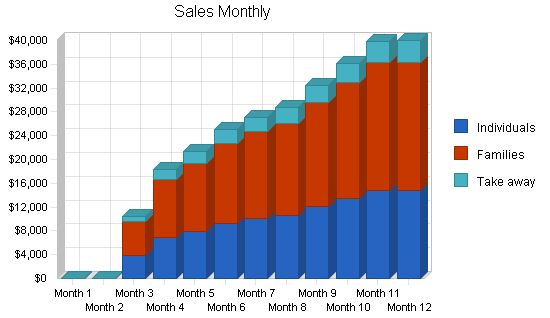
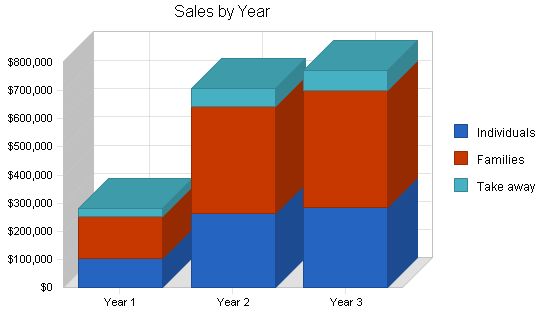
| Sales Forecast | |||
| Year 1 | Year 2 | Year 3 | |
| Sales | $103,710 | $262,527 | $286,024 |
| Individuals | $103,710 | $262,527 | $286,024 |
| Families | $150,304 | $380,474 | $414,528 |
| Take away | $25,401 | $64,300 | $70,055 |
| Total Sales | $279,415 | $707,301 | $770,608 |
| Direct Cost of Sales | Year 1 | Year 2 | Year 3 |
| Individuals | $46,669 | $118,137 | $128,711 |
| Families | $67,637 | $171,213 | $186,538 |
| Take away | $11,431 | $28,935 | $31,525 |
| Subtotal Direct Cost of Sales | $125,737 | $318,286 | $346,773 |
Contents
Management Summary
Kevin Lewis, President, CPA
- Duties: strategic development, back-office administration, financial analysis, internal control, server, and line cook.
- Education: BS general science and BS accounting, University of Oregon.
- Restaurant experience: two years as a server and busser.
- Business experience: staff accountant (Arthur Andersen) and controller (Hollywood Video).
Chef Darryl Darci, Executive Chef
- Duties: manages the back of the house, product development, kitchen hiring, kitchen training, and inventory management.
- Education: Western Culinary Institute.
- Restaurant Experience: fifteen years of restaurant experience at Harrah’s & JQ Hammonds. At JQ Hammonds ran an opening crew for new properties, also the executive sous chef managing 20 and plated 800 meals a day.
Erika Lewis, General Manager
- Duties: manages the front of the house, human resources, server hiring, server training, and quality control.
- Education: BS sociology, University of Oregon.
- Business experience: office and facilities manager, nCube Inc., managed a staff of five, managed system implementation and construction projects and negotiated satellite office lease.
Advisory Board
- John Stevens, VP Food Starbucks Coffee Co., Inc.
- Arthur Johnson, Former VP Real Estate Starbucks Coffee Co., Inc.
- Donald Davis, franchise owner of Sheraton Hotel and Tony Roma’s.
- Jerry Slippery, CPA, Partner, Arthur Anderson.
6.1 Personnel Plan
Kevin, Darryl, and Erika will all be working full time. In addition to this management team, there will be four other full-time employees brought on board during the end of the third month for the first store. The second store will see the hiring of five additional employees.
| Personnel Plan | |||
| Year 1 | Year 2 | Year 3 | |
| Kevin | $30,000 | $37,800 | $39,690 |
| Erika | $30,000 | $37,800 | $39,690 |
| Darryl | $62,000 | $75,600 | $79,380 |
| Full-time employee | $11,480 | $13,440 | $13,440 |
| Full-time employee | $11,480 | $13,440 | $13,440 |
| Full-time employee | $11,480 | $13,440 | $13,440 |
| Full-time employee | $10,472 | $13,440 | $13,440 |
| Full-time employee | $0 | $13,440 | $13,440 |
| Full-time employee | $0 | $13,440 | $13,440 |
| Full-time employee | $0 | $13,440 | $13,440 |
| Full-time employee | $0 | $13,440 | $13,440 |
| Full-time employee | $0 | $13,440 | $13,440 |
| Total People | 7 | 12 | 12 |
| Total Payroll | $166,912 | $272,160 | $279,720 |
Financial Plan
The following sections will outline important financial information.
7.1 Important Assumptions
The following table details important financial assumptions.
| General Assumptions | |||
| Year 1 | Year 2 | Year 3 | |
| Plan Month | 1 | 2 | 3 |
| Current Interest Rate | 10.00% | 10.00% | 10.00% |
| Long-term Interest Rate | 10.00% | 10.00% | 10.00% |
| Tax Rate | 30.00% | 30.00% | 30.00% |
| Other | 0 | 0 | 0 |
7.2 Break-even Analysis
The following topic and table shows our Break-even Analysis.
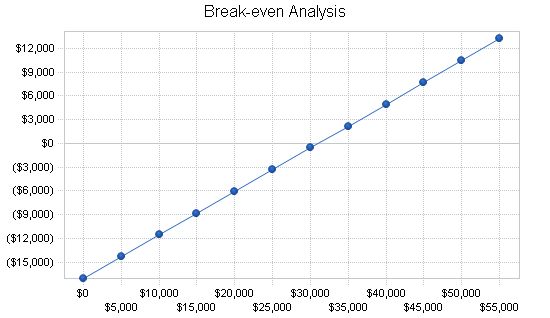
Break-even Analysis
Monthly Revenue Break-even: $31,017
Assumptions:
– Average Percent Variable Cost: 45%
– Estimated Monthly Fixed Cost: $17,059
Projected Profit and Loss:
The table below shows the projected profit and loss.
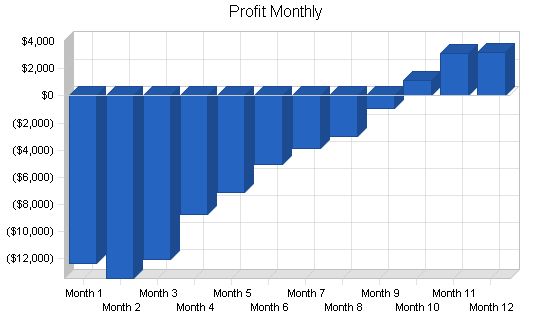
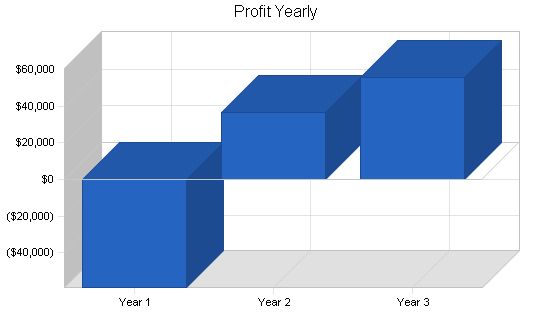
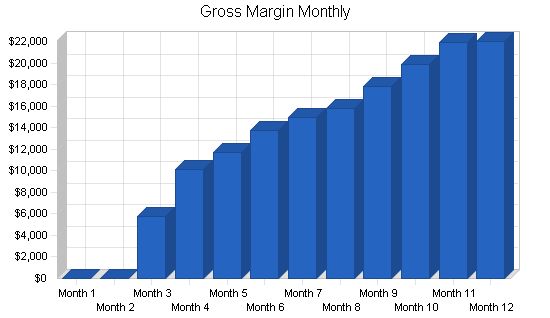
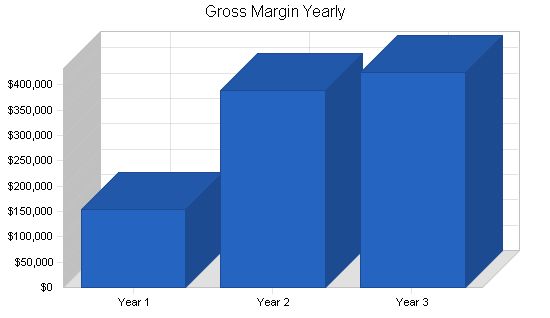
Pro Forma Profit and Loss:
Sales:
Year 1: $279,415
Year 2: $707,301
Year 3: $770,608
Direct Cost of Sales:
Year 1: $125,737
Year 2: $318,286
Year 3: $346,773
Other Production Expenses:
Year 1: $0
Year 2: $0
Year 3: $0
Total Cost of Sales:
Year 1: $125,737
Year 2: $318,286
Year 3: $346,773
Gross Margin:
Year 1: $153,678
Year 2: $389,016
Year 3: $423,834
Gross Margin %: 55.00%
Expenses:
Payroll:
Year 1: $166,912
Year 2: $272,160
Year 3: $279,720
Sales and Marketing and Other Expenses:
Year 1: $2,400
Year 2: $2,400
Year 3: $2,400
Depreciation:
Year 1: $15,000
Year 2: $15,000
Year 3: $15,000
Leased Equipment:
Year 1: $0
Year 2: $0
Year 3: $0
Utilities:
Year 1: $0
Year 2: $0
Year 3: $0
Insurance:
Year 1: $2,400
Year 2: $3,600
Year 3: $3,600
Rent:
Year 1: $18,000
Year 2: $36,000
Year 3: $36,000
Payroll Taxes:
Year 1: $0
Year 2: $0
Year 3: $0
Other:
Year 1: $0
Year 2: $0
Year 3: $0
Total Operating Expenses:
Year 1: $204,712
Year 2: $329,160
Year 3: $336,720
Profit Before Interest and Taxes:
Year 1: ($51,034)
Year 2: $59,856
Year 3: $87,114
EBITDA:
Year 1: ($36,034)
Year 2: $74,856
Year 3: $102,114
Interest Expense:
Year 1: $8,000
Year 2: $8,000
Year 3: $8,000
Taxes Incurred:
Year 1: $0
Year 2: $15,557
Year 3: $23,734
Net Profit:
Year 1: ($59,034)
Year 2: $36,299
Year 3: $55,380
Net Profit/Sales:
Year 1: -21.13%
Year 2: 5.13%
Year 3: 7.19%
Projected Cash Flow:
The following chart and table indicate projected cash flow.
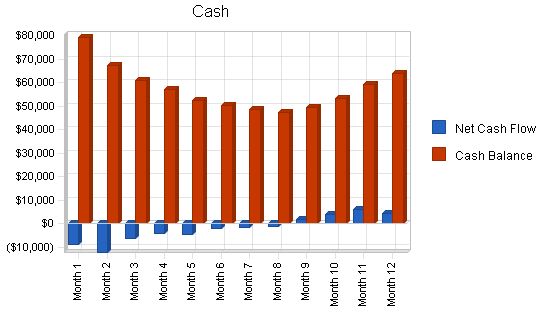
Pro Forma Cash Flow:
| Year 1 | Year 2 | Year 3 | |
| Cash Received | |||
| Cash from Operations | |||
| Cash Sales | $279,415 | $707,301 | $770,608 |
| Subtotal Cash from Operations | $279,415 | $707,301 | $770,608 |
| Additional Cash Received | |||
| Sales Tax, VAT, HST/GST Received | $0 | $0 | $0 |
| New Current Borrowing | $0 | $0 | $0 |
| New Other Liabilities (interest-free) | $0 | $0 | $0 |
| New Long-term Liabilities | $0 | $0 | $0 |
| Sales of Other Current Assets | $0 | $0 | $0 |
| Sales of Long-term Assets | $0 | $0 | $0 |
| New Investment Received | $0 | $0 | $0 |
| Subtotal Cash Received | $279,415 | $707,301 | $770,608 |
Projected Balance Sheet:
| Year 1 | Year 2 | Year 3 | |
| Assets | |||
| Current Assets | |||
| Cash | $63,713 | $126,714 | $200,107 |
| Other Current Assets | $0 | $0 | $0 |
| Total Current Assets | $63,713 | $126,714 | $200,107 |
| Long-term Assets | |||
| Long-term Assets | $75,000 | $75,000 | $75,000 |
| Accumulated Depreciation | $15,000 | $30,000 | $45,000 |
| Total Long-term Assets | $60,000 | $45,000 | $30,000 |
| Total Assets | $123,713 | $171,714 | $230,107 |
| Liabilities and Capital | |||
| Current Liabilities | |||
| Accounts Payable | $19,846 | $31,549 | $34,562 |
| Current Borrowing | $0 | $0 | $0 |
| Other Current Liabilities | $0 | $0 | $0 |
| Subtotal Current Liabilities | $19,846 | $31,549 | $34,562 |
| Long-term Liabilities | $80,000 | $80,000 | $80,000 |
| Total Liabilities | $99,846 | $111,549 | $114,562 |
| Paid-in Capital | $85,000 | $85,000 | $85,000 |
| Retained Earnings | ($2,100) | ($61,134) | ($24,835) |
| Earnings | ($59,034) | $36,299 | $55,380 |
| Total Capital | $23,866 | $60,165 | $115,545 |
| Total Liabilities and Capital | $123,713 | $171,714 | $230,107 |
| Net Worth | $23,866 | $60,165 | $115,545 |
| Year 1 | Year 2 | Year 3 | Industry Profile | ||||||||||
| Sales Growth | 0.00% | 153.14% | 8.95% | 7.60% | |||||||||
| Percent of Total Assets | |||||||||||||
| Other Current Assets | 0.00% | 0.00% | 0.00% | 35.60% | |||||||||
| Total Current Assets | 51.50% | 73.79% | 86.96% | 43.70% | |||||||||
| Long-term Assets | 48.50% | 26.21% | 13.04% | 56.30% | |||||||||
| Total Assets | 100.00% | 100.00% | 100.00% | 100.00% | |||||||||
| Current Liabilities | |||||||||||||
| Accounts Payable | 16.04% | 18.37% | 15.02% | 32.70% | |||||||||
| Long-term Liabilities | 64.67% | 46.59% | 34.77% | 28.50% | |||||||||
| Total Liabilities | 80.71% | 64.96% | 49.79% | 61.20% | |||||||||
| Net Worth | 19.29% | 35.04% | 50.21% | 38.80% | |||||||||
| Percent of Sales | |||||||||||||
| Sales | 100.00% | 100.00% | 100.00% | 100.00% | |||||||||
| Gross Margin | 55.00% | 55.00% | 55.00% | 60.50% | |||||||||
| Selling, General & Administrative Expenses | 91.28% | 55.14% | 51.74% | 39.80% | |||||||||
| Advertising Expenses | 0.43% | 0.17% | 0.16% | 3.20% | |||||||||
| Profit Before Interest and Taxes | -18.26% | 8.46% | 11.30% | 0.70% | |||||||||
| Main Ratios | |||||||||||||
| Current | 3.21 | 4.02 | 5.79 | 0.98 | |||||||||
| Quick | 3.21 | 4.02 | 5.79 | 0.65 | |||||||||
| Total Debt to Total Assets | 80.71% | 64.96% | 49.79% | 61.20% | |||||||||
| Pre-tax Return on Net Worth | -247.35% | 86.19% | 68.47% | 1.70% | |||||||||
| Pre-tax Return on Assets | -47.72% | 30.20% | 34.38% | 4.30% | |||||||||
| Additional Ratios | |||||||||||||
| Net Profit Margin | -21.13% | 5.13% | 7.19% | n.a | |||||||||
| Return on Equity | -247.35% | 60.33% | 47.93% | n.a | |||||||||
| Activity Ratios | |||||||||||||
| Accounts Payable Turnover | 7.89 | 12.17 | 12.17 | n.a | |||||||||
| Payment Days | 27 | 24 | 29 | n.a | |||||||||
| Total Asset Turnover | 2.26 | 4.12 | 3.35 | n.a | |||||||||
| Debt Ratios | |||||||||||||
| Debt to Net Worth | 4.18 | 1.85 | 0.99 | n.a | |||||||||
| Current Liab. to Liab. | 0.20 | 0.28 | 0.30 | n.a | |||||||||
| Personnel Plan | |||||||||||||
| Month 1 | Month 2 | Month 3 | Month 4 | Month 5 | Month 6 | Month 7 | Month 8 | Month 9 | Month 10 | Month 11 | Month 12 | ||
| Kevin | $2,500 | $2,500 | $2,500 | $2,500 | $2,500 | $2,500 | $2,500 | $2,500 | $2,500 | $2,500 | $2,500 | $2,500 | |
| Erika | $2,500 | $2,500 | $2,500 | $2,500 | $2,500 | $2,500 | $2,500 | $2,500 | $2,500 | $2,500 | $2,500 | $2,500 | |
| Darryl | $3,500 | $3,500 | $5,500 | $5,500 | $5,500 | $5,500 | $5,500 | $5,500 | $5,500 | $5,500 | $5,500 | $5,500 | |
| Full time employee | $0 | $280 | $1,120 | $1,120 | $1,120 | $1,120 | $1,120 | $1,120 | $1,120 | $1,120 | $1,120 | $1,120 | |
| Full time employee | $0 | $280 | $1,120 | $1,120 | $1,120 | $1,120 | $1,120 | $1,120 | $1,120 | $1,120 | $1,120 | $1,120 | |
| Full time employee | $0 | $280 | $1,120 | $1,120 | $1,120 | $1,120 | $1,120 | $1,120 | $1,120 | $1,120 | $1,120 | $1,120 | |
| Full time employee | $0 | $280 | $112 | $1,120 | $1,120 | $1,120 | $1,120 | $1,120 | $1,120 | $1,120 | $1,120 | $1,120 | |
| Full time employee | $0 | $0 | $0 | $0 | $0 | $0 | $0 | $0 | $0 | $0 | $0 | $0 | |
| Full time employee | $0 | $0 | $0 | $0 | $0 | $0 | $0 | $0 | $0 | $0 | $0 | $0 | |
| Full time employee | $0 | $0 | $0 | $0 | $0 | $0 | $0 | $0 | $0 | $0 | $0 | $0 | |
| Full time employee | $0 | $0 | $0 | $0 | $0 | $0 | $0 | $0 | $0 | $0 | $0 | $0 | |
| Total People | 3 | 7 | 7 | 7 | 7 | 7 | 7 | 7 | 7 | 7 | 7 | 7 | |
| Total Payroll | $8,500 | $9,620 | $13,972 | $14,980 | $14,980 | $14,980 | $14,980 | $14,980 | $14,980 | $14,980 | $14,980 | $14,980 | |
| General Assumptions | |||||||||||||
| Month 1 | Month 2 | Month 3 | Month 4 | Month 5 | Month 6 | Month 7 | Month 8 | Month 9 | Month 10 | Month 11 | Month 12 | ||
| Plan Month | 1 | 2 | 3 | 4 | 5 | 6 | 7 | 8 | 9 | 10 | 11 | 12 | |
| Current Interest Rate | 10.00% | 10.00% | 10.00% | 10.00% | 10.00% | 10.00% | 10.00% | 10.00% | 10.00% | 10.00% | 10.00% | 10.00% | |
| Long-term Interest Rate | 10.00% | 10.00% | 10.00% | 10.00% | 10.00% | 10.00% | 10.00% | 10.00% | 10.00% | 10.00% | 10.00% | 10.00% | |
| Tax Rate | 30.00% | 30.00% | 30.00% | 30.00% | 30.00% | 30.00% | 30.00% | 30.00% | 30.00% | 30.00% | 30.00% | 30.00% | |
| Other | 0 | 0 | 0 | 0 | 0 | 0 | 0 | 0 | 0 | 0 | 0 | 0 | |
| Pro Forma Profit and Loss | |||||||||||||
| Month 1 | Month 2 | Month 3 | Month 4 | Month 5 | Month 6 | Month 7 | Month 8 | Month 9 | Month 10 | Month 11 | Month 12 | ||
| Sales | $0 | $0 | $10,494 | $18,356 | $21,300 | $25,018 | $27,095 | $28,731 | $32,449 | ||||
| Pro Forma Cash Flow | |||||||||||||
| Month 1 | Month 2 | Month 3 | Month 4 | Month 5 | Month 6 | Month 7 | Month 8 | Month 9 | Month 10 | Month 11 | Month 12 | ||
| Cash Received | |||||||||||||
| Cash from Operations | |||||||||||||
| Cash Sales | $0 | $0 | $10,494 | $18,356 | $21,300 | $25,018 | $27,095 | $28,731 | $32,449 | $36,167 | $39,885 | $39,920 | |
| Subtotal Cash from Operations | $0 | $0 | $10,494 | $18,356 | $21,300 | $25,018 | $27,095 | $28,731 | $32,449 | $36,167 | $39,885 | $39,920 | |
| Additional Cash Received | |||||||||||||
| Sales Tax, VAT, HST/GST Received | 0.00% | $0 | $0 | $0 | $0 | $0 | $0 | $0 | $0 | $0 | $0 | $0 | $0 |
| New Current Borrowing | $0 | $0 | $0 | $0 | $0 | $0 | $0 | $0 | $0 | $0 | $0 | ||
| New Other Liabilities (interest-free) | $0 | $0 | $0 | $0 | $0 | $0 | $0 | $0 | $0 | $0 | $0 | ||
| New Long-term Liabilities | $0 | $0 | $0 | $0 | $0 | $0 | $0 | $0 | $0 | $0 | $0 | ||
| Sales of Other Current Assets | $0 | $0 | $0 | $0 | $0 | $0 | $0 | $0 | $0 | $0 | $0 | ||
| Sales of Long-term Assets | $0 | $0 | $0 | $0 | $0 | $0 | $0 | $0 | $0 | $0 | $0 | ||
| New Investment Received | $0 | $0 | $0 | $0 | $0 | $0 | $0 | $0 | $0 | $0 | $0 | ||
| Subtotal Cash Received | $0 | $0 | $10,494 | $18,356 | $21,300 | $25,018 | $27,095 | $28,731 | $32,449 | $36,167 | $39,885 | $39,920 | |
| Expenditures | Month 1 | Month 2 | Month 3 | Month 4 | Month 5 | Month 6 | Month 7 | Month 8 | Month 9 | Month 10 | Month 11 | Month 12 | |
| Expenditures from Operations | |||||||||||||
| Cash Spending | $8,500 | $9,620 | $13,972 | $14,980 | $14,980 | $14,980 | $14,980 | $14,980 | $14,980 | $14,980 | $14,980 | $14,980 | |
| Bill Payments | $86 | $2,567 | $2,724 | $7,407 | $10,871 | $12,208 | $13,856 | $14,784 | $15,551 | $17,224 | $18,898 | $20,515 | |
| Subtotal Spent on Operations | $8,586 | $12,187 | $16,696 | $22,387 | $25,851 | $27,188 | $28,836 | $29,764 | $30,531 | $32,204 | $33,878 | $35,495 | |
| Additional Cash Spent | |||||||||||||
| Sales Tax, VAT, HST/GST Paid Out | $0 | $0 | $0 | $0 | $0 | $0 | $0 | $0 | $0 | $0 | $0 | ||
| Principal Repayment of Current Borrowing | $0 | $0 | $0 | $0 | $0 | $0 | $0 | $0 | $0 | $0 | $0 | ||
| Other Liabilities Principal Repayment | $0 | $0 | $0 | $0 | $0 | $0 | $0 | $0 | $0 | $0 | $0 | ||
| Long-term Liabilities Principal Repayment | $0 | $0 | $0 | $0 | $0 | $0 | $0 | $0 | $0 | $0 | $0 | ||
| Purchase Other Current Assets | $0 | $0 | $0 | $0 | $0 | $0 | $0 | $0 | $0 | $0 | $0 | ||
| Purchase Long-term Assets | $0 | $0 | $0 | $0 | $0 | $0 | $0 | $0 | $0 | $0 | $0 | ||
| Dividends | $0 | $0 | $0 | $0 | $0 | $0 | $0 | $0 | $0 | $0 | $0 | ||
| Subtotal Cash Spent | $8,586 | $12,187 | $16,696 | $22,387 | $25,851 | $27,188 | $28,836 | $29,764 | $30,531 | $32,204 | $33,878
Business Plan Outline
|
||
Hello!
I’m Andrew Brooks, a seasoned finance consultant from the USA and the mind behind phonenumber247.com.
My career is built on a foundation of helping individuals and businesses thrive financially in an ever-changing economic landscape. At phonenumber247.com, my aim is to demystify the complex world of finance, providing clear, actionable advice that can help you navigate your financial journey with confidence. Whether it’s personal finance management, investment strategies, or understanding the nuances of market dynamics, I’m here to share insights and tools that can propel you towards your financial goals.
Welcome to my digital space, where every piece of advice is a step closer to financial clarity and success!
